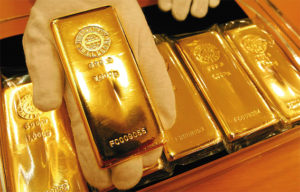 Gold traded little changed on Thursday, after yesterday it touched one-week high, following a private report that showed lower-than-expected jobs growth in the US, which boosted speculation the official government data tomorrow will trail projections. Assets in the SPDR Gold Trust, the biggest bullion-backed ETF, remained unchanged on Wednesday, after rising 0.5% on February 4, the most since January 17.
Gold traded little changed on Thursday, after yesterday it touched one-week high, following a private report that showed lower-than-expected jobs growth in the US, which boosted speculation the official government data tomorrow will trail projections. Assets in the SPDR Gold Trust, the biggest bullion-backed ETF, remained unchanged on Wednesday, after rising 0.5% on February 4, the most since January 17.
On the Comex division of the New York Mercantile Exchange, gold futures for settlement in April traded at $1 257.80 per troy ounce by 07:45 GMT, adding 0.07% for the day. Prices touched a session high at $1 259.20 per troy ounce, while day’s low was touched at $1 255.00 an ounce. Yesterday, the yellow metal touched $1 274.10 per troy ounce, the strongest level since January 27th.
Gold futures settled the 5-day period 2% lower, snapping five consecutive weeks of gains, the longest rally since September 2012. The yellow metal advanced 3.4% in January as MSCI All-Country World Index of equities plunged 4.1% amid concern that a slump in emerging markets may worsen. However, gold settled last year 28% lower, the steepest annual decline since 1981 as investors lost faith in the metal as a store of value and amid speculation Fed will continue scaling back its monetary stimulus throughout 2014.
Fed stimulus outlook
The yellow metal drew support as few downbeat reports cast some doubt that the Federal Reserve will keep scaling back its stimulus at each policy meeting, before exiting the program at the end of the year.
Yesterday, Automatic Data Processing Inc. (ADP) reported today that the US private sector added 175 000 new jobs in January, trailing analysts’ expectations of an increase to 185 000. At the same time, new jobs added in December were downward revised to 227 000 from earlier estimates of 238 000. The ADP index is released two days before the release of the official data by the US Department of Labor. The report, due to be published on Friday, may show non-farm payrolls increased by 180 000 in January, after they rose by 74 000 in December, the weakest level since June 2012.
On Tuesday, the US Census Bureau reported that factory orders decreased 1.5% in December, less than the median analysts’ forecast of a 1.8% drop. In November the orders for factory goods rose by 1.8%.
The US Institute for Supply Management (ISM) reported on Monday, that its manufacturing index declined to the lowest level in seven months in January, due to a slump in new orders.
The report revealed that the manufacturing index stood at 51.3 in January, down from December’s reading of 57.0, while analysts had projected that the index will slow down to 56.0 in January. Data also showed that new orders plunged at the fastest pace since December 1980, as the new orders index declined to 51.2 in January from 64.4 in the previous month. Most of the companies cited the bad US weather conditions last month as the main reason for the decreased number of new orders.
However, gold prices continued to be pressured, as last week Fed policy makers reached an unanimous decision to cut Fed’s monthly bond purchases for a second straight meeting by another $10 billion. This was the first meeting without dissent since June 2011 as policy makers were brought together by concern over Fed’s swelled balanced sheet which raised risks of asset bubbles.
The Federal Open Market Committee said it will further trim the central bank’s Quantitative Easing program based on improving labor market conditions and as economic growth accelerated in the recent quarters.
The central bank will probably continue to pare stimulus by $10 billion at each policy meeting before exiting the program in December, according to a Bloomberg News survey of 41 economists, conducted on January 10th.
A stronger US dollar also weighed on prices. The US dollar index, which measures the greenback’s performance against a basket of six major peers, rose by 0.05% on Thursday to trade at 81.19 by 07:40 GMT. Prices shifted in a daily range between day’s high and low, 81.22 and 81.12. Strengthening of the dollar makes commodities priced in it more expensive for foreign currency holders and limits their appeal as an alternative investment.
Assets in the SPDR Gold Trust, the biggest bullion-backed ETP, remained unchanged after rising 0.5% on February 4, the most since January 17. The fund has lost 41% of its holdings in 2013. A total of 553 tons has been withdrawn in 2013. Billionaire hedge-fund manager John Paulson who holds the biggest stake in the SPDR Gold Trust told clients on November 20 that he wouldn’t invest more money in his gold fund because it isn’t clear when inflation will accelerate.





